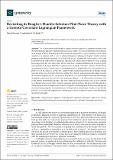Revisiting de Broglie’s Double-Solution Pilot-Wave Theory with a Lorentz-Covariant Lagrangian Framework
Author(s)
Darrow, David; Bush, John W. M.
Downloadsymmetry-16-00149.pdf (2.504Mb)
Publisher with Creative Commons License
Publisher with Creative Commons License
Creative Commons Attribution
Terms of use
Metadata
Show full item recordAbstract
The relation between de Broglie’s double-solution approach to quantum dynamics and the hydrodynamic pilot-wave system has motivated a number of recent revisitations and extensions of de Broglie’s theory. Building upon these recent developments, we here introduce a rich family of pilot-wave systems, with a view to reformulating and studying de Broglie’s double-solution program in the modern language of classical field theory. Notably, the entire family is local and Lorentz-invariant, follows from a variational principle, and exhibits time-invariant, two-way coupling between particle and pilot-wave field. We first introduce a variational framework for generic pilot-wave systems, including a derivation of particle-wave exchange of Noether currents. We then focus on a particular limit of our system, in which the particle is propelled by the local gradient of its pilot wave. In this case, we see that the Compton-scale oscillations proposed by de Broglie emerge naturally in the form of particle vibrations, and that the vibration modes dynamically adjust to match the Compton frequency in the rest frame of the particle. The underlying field dynamically changes its radiation patterns in order to satisfy the de Broglie relation p=ℏk at the particle’s position, even as the particle momentum p changes. The wave form and frequency thus evolve so as to conform to de Broglie’s harmony of phases, even for unsteady particle motion. We show that the particle is always dressed with a Compton-scale Yukawa wavepacket, independent of its trajectory, and that the associated energy imparts a constant increase to the particle’s inertial mass. Finally, we see that the particle’s wave-induced Compton-scale oscillation gives rise to a classical version of the Heisenberg uncertainty principle.
Date issued
2024-01-26Department
Massachusetts Institute of Technology. Department of MathematicsJournal
Symmetry
Publisher
MDPI AG
Citation
Darrow, D.; Bush, J.W.M. Revisiting de Broglie’s Double-Solution Pilot-Wave Theory with a Lorentz-Covariant Lagrangian Framework. Symmetry 2024, 16, 149.
Version: Final published version
ISSN
2073-8994
Keywords
Physics and Astronomy (miscellaneous), General Mathematics, Chemistry (miscellaneous), Computer Science (miscellaneous)